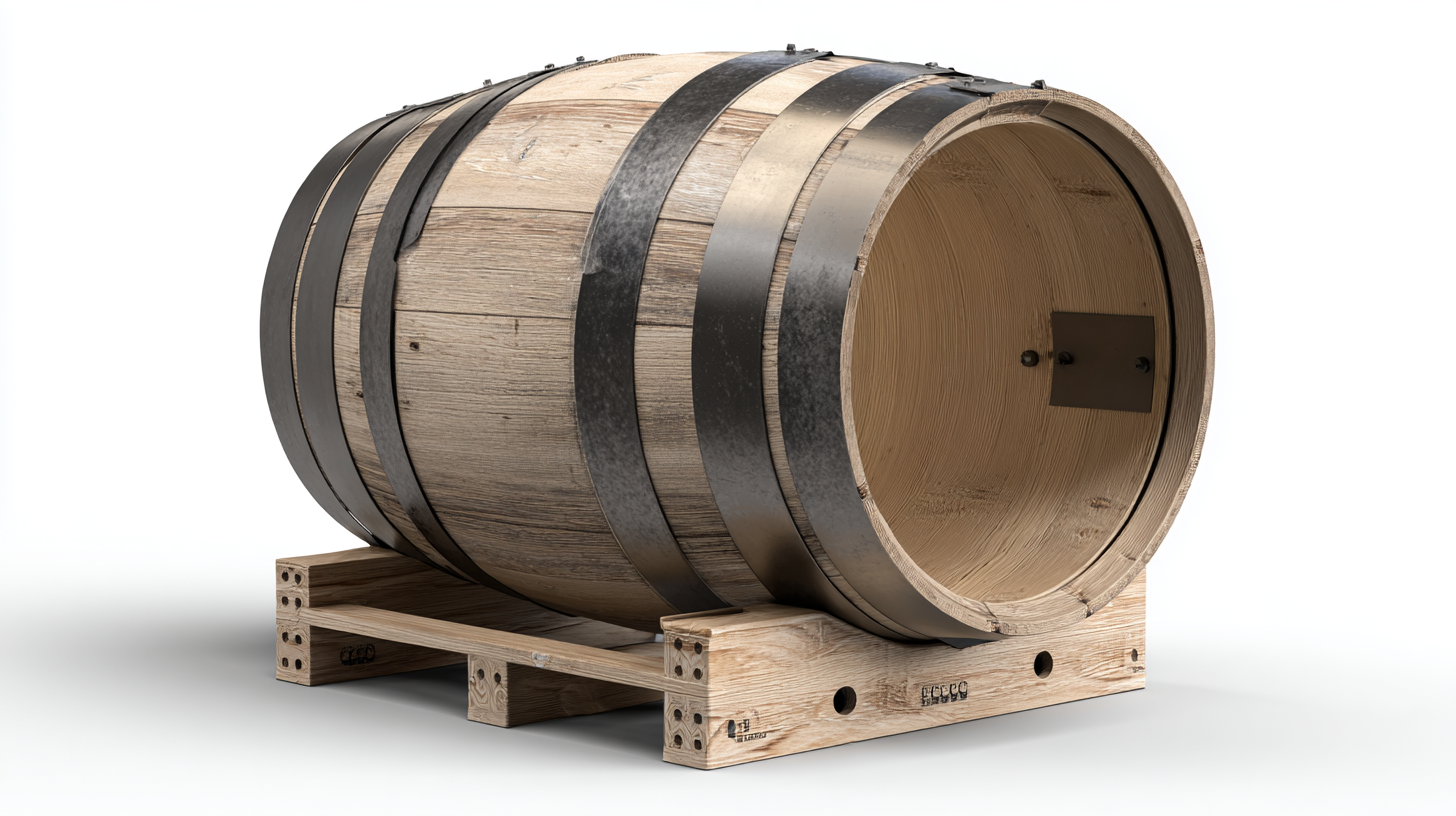Unveiling the Secrets of Drum Barrels: Essential Guide for Eco-Friendly Storage Solutions
In an era where sustainability is paramount, discovering eco-friendly storage solutions has become essential for businesses and individuals alike. Among the myriad of options available, the drum barrel stands out as a versatile and efficient storage solution.
This guide delves into the secrets of drum barrels, revealing their numerous benefits and applications across various industries. From facilitating safe chemical storage to serving as creative design elements in homes, drum barrels not only meet practical storage needs but also align with eco-conscious practices.
We will explore the best types of drum barrels available, offering insights on how to select the right one for your specific requirements while promoting a greener planet. Join us as we unveil the potential of drum barrels and their role in sustainable living.
Understanding the Types of Drum Barrels for Eco-Friendly Storage
 Drum barrels have emerged as a vital component in eco-friendly storage solutions, with various types catering to different environmental needs. One of the most common varieties, the plastic drum, is lightweight, corrosion-resistant, and recyclable, making it an excellent choice for storing liquids safely. These barrels are available in several sizes and are often used for chemicals and food storage, ensuring that the contents remain uncontaminated and secure. Additionally, their modular design makes them easy to stack and transport, minimizing the carbon footprint associated with storage and logistics.
Drum barrels have emerged as a vital component in eco-friendly storage solutions, with various types catering to different environmental needs. One of the most common varieties, the plastic drum, is lightweight, corrosion-resistant, and recyclable, making it an excellent choice for storing liquids safely. These barrels are available in several sizes and are often used for chemicals and food storage, ensuring that the contents remain uncontaminated and secure. Additionally, their modular design makes them easy to stack and transport, minimizing the carbon footprint associated with storage and logistics.
Metal drum barrels, particularly those made from recycled materials, also play a significant role in sustainable storage practices. Steel drums are known for their durability and can be reused multiple times, making them a sustainable option for long-term storage needs. They are ideal for hazardous materials due to their robustness and spill prevention capabilities. Similarly, fiber drums offer a lightweight alternative that is biodegradable and recyclable, catering to businesses looking to reduce their environmental impact. By understanding the various types of drum barrels available, companies can make informed choices that align with their eco-friendly goals while ensuring efficient storage solutions.
Key Materials Used in Eco-Conscious Drum Barrels
Drum barrels have evolved significantly in recent years, particularly in the context of eco-friendly storage solutions. One of the key factors driving this evolution is the selection of sustainable materials used in their production. According to a report by the Environmental Protection Agency (EPA), traditional plastic and metal barrels contribute substantially to environmental waste, with millions ending up in landfills annually. As a response, manufacturers are increasingly turning to recyclable and biodegradable materials. For example, barrels made from high-density polyethylene (HDPE) can be recycled multiple times, significantly reducing their lifecycle impact.
 Additionally, the use of natural materials like bamboo and wood has gained traction in the eco-conscious market. These renewable resources not only diminish the carbon footprint associated with production but also provide a sturdy and aesthetic alternative to conventional drums. Research by the Sustainable Packaging Coalition indicates that using sustainable materials can reduce greenhouse gas emissions by up to 30% compared to traditional materials. This shift towards eco-friendly drum barrels not only meets regulatory standards but resonates with consumers increasingly prioritizing sustainability in their purchasing decisions.
Additionally, the use of natural materials like bamboo and wood has gained traction in the eco-conscious market. These renewable resources not only diminish the carbon footprint associated with production but also provide a sturdy and aesthetic alternative to conventional drums. Research by the Sustainable Packaging Coalition indicates that using sustainable materials can reduce greenhouse gas emissions by up to 30% compared to traditional materials. This shift towards eco-friendly drum barrels not only meets regulatory standards but resonates with consumers increasingly prioritizing sustainability in their purchasing decisions.
Best Practices for Cleaning and Maintaining Drum Barrels
Maintaining drum barrels is crucial for ensuring the longevity and safety of eco-friendly storage solutions. According to a report by the Environmental Protection Agency, around 15% of hazardous materials leaks from improperly maintained barrels, leading to significant environmental and financial repercussions. Therefore, regular cleaning and maintenance are vital. To start, rinsing the barrels with appropriate solvents based on previous contents can prevent chemical interactions that might degrade the barrel’s integrity. Using biodegradable cleaners not only protects the environment but also ensures compliance with regulatory standards.
In addition to cleaning, it is essential to conduct regular inspections for signs of rust, corrosion, or structural damage. Industry standards recommend visual inspections every three months, as stated in the National Association of Chemical Distributors' guidelines. This proactive approach helps in identifying issues before they escalate. Furthermore, storing barrels in a sheltered location, away from direct sunlight and extreme weather, can reduce wear and tear significantly. By following these best practices, businesses can not only extend the life of their drum barrels but also contribute to a greener planet.
Creative Repurposing Ideas for Old Drum Barrels
Repurposing old drum barrels offers a unique opportunity to blend creativity and sustainability in home décor and storage solutions. These versatile containers, once used for industrial purposes, can be transformed into stunning furniture pieces or functional garden elements. For instance, cutting a barrel in half can create charming planters, which add a rustic touch to outdoor spaces. Alternatively, you can sand and finish a barrel to craft a side table that becomes a conversation starter in your living room.
Moreover, these drum barrels are not just about aesthetics; they provide eco-friendly storage solutions as well. By using them to store tools or gardening supplies, you not only keep your space organized but also give a second life to materials that might otherwise contribute to waste. Creative ideas abound; for instance, grouping several barrels can create a unique shelving unit, while smaller barrels can serve as quirky storage bins for art supplies. Embracing these innovative repurposing strategies not only enhances your home but also aligns with sustainable practices that are increasingly important in today's world.
How to Choose the Right Drum Barrel for Your Storage Needs
When selecting the right drum barrel for eco-friendly storage solutions, it's crucial to consider your specific application needs across various sectors such as BFSI, IT and telecommunications, government, manufacturing, healthcare, and retail. Each industry has distinct requirements that influence the choice of materials, sizes, and features of drum barrels. For instance, the healthcare sector may prioritize barrels that comply with strict safety standards, while manufacturing might focus on durability and resistance to chemicals. Identifying these unique needs is essential for optimizing storage effectiveness and sustainability.
In addition to industry-specific considerations, regional factors also play a significant role in selecting the appropriate drum barrels. Variations in regulations, climate conditions, and local availability of materials can impact the decision-making process. For example, a region with stringent environmental regulations may necessitate the use of biodegradable or recyclable materials in drum barrel production. Furthermore, the rise of distributed storage solutions aligns with the increasing demands from industries for robust storage options that are both efficient and environmentally friendly. Therefore, systematic evaluation based on industry and regional insights is vital when choosing the right drum barrel for your storage requirements.








 Additionally, the use of natural materials like
Additionally, the use of natural materials like 








